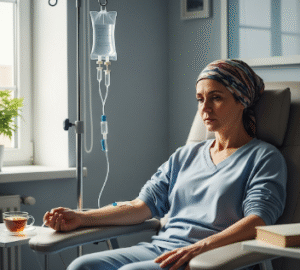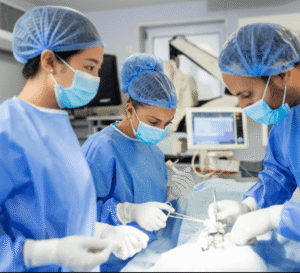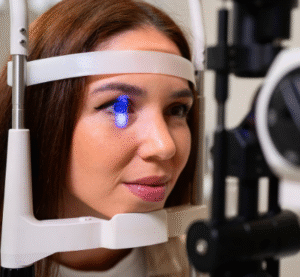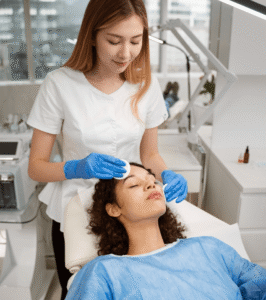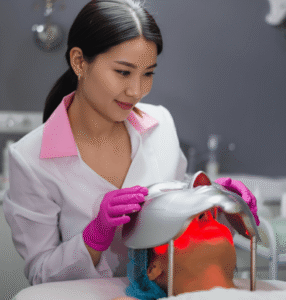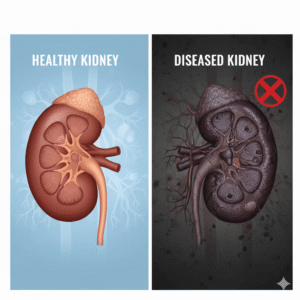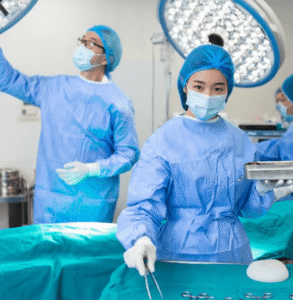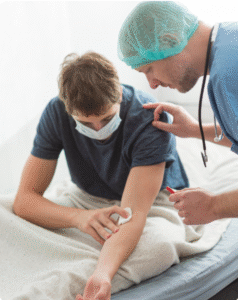Dermatologic care for sun-triggered rashes and skin sensitivity
What it is
Polymorphic Light Eruption (PMLE) is the most common form of sun allergy. It is characterized by an itchy, red rash that appears hours or days after exposure to sunlight, particularly in spring and early summer when sun intensity suddenly increases.
The rash can take different forms — small red bumps, plaques, or blisters — hence the term “polymorphic.” It most often affects sun-exposed areas such as the chest, arms, legs, and face, while skin that is regularly exposed (like the hands) may remain unaffected due to gradual tolerance.
PMLE is not contagious, but it can be uncomfortable, recurrent, and emotionally distressing, especially for individuals sensitive to sunlight. In Korea, management focuses on preventing flare-ups, treating symptoms, and gradually building tolerance through advanced dermatology practices.
Why it’s done
Managing PMLE is important because it directly affects quality of life.
✔ Symptom relief – Reduces itching, burning, and discomfort.
✔ Prevention of recurrence – Helps patients enjoy outdoor activities without fear of sudden rash.
✔ Cosmetic reassurance – Prevents visible rashes from becoming a source of embarrassment.
✔ Long-term skin health – Prevents chronic inflammation and post-inflammatory pigmentation.
✔ Psychological well-being – Offers confidence and reduces anxiety around sunlight exposure.
Alternatives
PMLE can be managed through several approaches.
→ Strict sun avoidance – Staying indoors or covering exposed skin during peak UV hours.
→ Broad-spectrum sunscreens – High-SPF (50+) creams reapplied every 2–3 hours outdoors.
→ Topical corticosteroids – To control acute inflammation.
→ Oral antihistamines – For itch relief.
→ Phototherapy hardening – Controlled UV exposure in clinics to build skin tolerance before sunny seasons.
→ Immunosuppressive medications – Such as hydroxychloroquine, used only in severe, resistant cases.
Korean clinics often recommend a combined regimen of avoidance, sunscreen, and phototherapy hardening for best results.
Preparation
Before starting a management plan, preparation includes:
➤ Dermatologic evaluation – Confirm diagnosis and exclude lupus or other photodermatoses.
➤ Medical history – Review of previous reactions, timing, and severity.
➤ Phototesting – Controlled UV exposure to identify sensitivity thresholds.
➤ Skin care planning – Choosing appropriate sunscreens, moisturizers, and topical treatments.
➤ Patient education – Guidance on lifestyle adjustments, safe clothing, and emergency care.
How it’s done
PMLE management typically involves a step-by-step regimen.
➔ Acute flare management –
- Topical corticosteroids reduce inflammation.
- Oral antihistamines relieve itching.
- Cool compresses soothe irritation.
➔ Preventive care –
- Daily use of broad-spectrum sunscreens with UVA and UVB protection.
- Use of UV-protective clothing, hats, and sunglasses.
- Avoiding sudden long sun exposures in spring/early summer.
➔ Phototherapy hardening –
- Conducted in Korean dermatology clinics.
- Controlled UVB or UVA light exposure is given 2–3 times per week for several weeks.
- Builds tolerance before peak sun seasons, reducing risk of flare-ups.
➔ Adjunct therapies –
- Antioxidant creams or supplements to support skin defense.
- Mild immunomodulators in resistant cases, under medical supervision.
Recovery
Recovery depends on whether treatment is acute or preventive.
→ Flare-ups typically resolve within 1–2 weeks with corticosteroids and sun avoidance.
→ With phototherapy hardening, many patients notice significant improvement in tolerance, reducing or eliminating rashes during summer.
→ Emotional recovery includes restored confidence to engage in outdoor activities.
→ Preventive strategies help patients enjoy vacations, sports, and daily outdoor life with fewer restrictions.
Complications
While PMLE is not dangerous, complications can arise without proper management.
✔ Persistent itching and scratching – leading to skin damage.
✔ Infections – Secondary bacterial infection from open lesions.
✔ Pigmentation changes – Dark or light patches after repeated flare-ups.
✔ Chronic discomfort – Recurrent episodes can affect lifestyle and outdoor participation.
✔ Emotional distress – Patients may feel anxious about sun exposure and avoid social activities.
In Korea, complications are minimized with early diagnosis, preventive strategies, and personalized therapy.
Treatment options in Korea
Korea offers world-class dermatologic solutions for PMLE.
➤ Specialized photodermatology clinics – Equipped with advanced UV testing and phototherapy devices.
➤ Personalized hardening regimens – UV exposure is tailored to individual skin type and sensitivity.
➤ Innovative sunscreen formulations – Lightweight, high-SPF Korean sunscreens are prescribed for daily use.
➤ Integrated care – Dermatologists combine medical treatment with cosmetic skincare to reduce pigmentation and scarring.
➤ Patient education programs – Structured counseling on sun avoidance and safe lifestyle practices.
➤ International patient support – Bilingual consultations and flexible schedules are available for medical tourists.
➤ Research and development – Korea contributes to global advancements in light therapy and sunscreen innovation, ensuring the latest evidence-based care.


